-
ORIGINAL ARTICLE11-22-2024
Bedside rounds in the hospital environment from the perspective of multiprofessional health teams
Revista Brasileira de Enfermagem. 2024;77(5):e20230493
Abstract
ORIGINAL ARTICLEBedside rounds in the hospital environment from the perspective of multiprofessional health teams
Revista Brasileira de Enfermagem. 2024;77(5):e20230493
DOI 10.1590/0034-7167-2023-0493
Views0ABSTRACT
Objective:
To analyze the configuration of power relations among the multiprofessional team in the bedside round process in the hospital.
Methods:
Qualitative research with data analyzed through discourse analysis, based on Michel Foucault’s theoretical framework. From September to December 2022, we conducted interviews and field observations with the multiprofessional team at a hospital in Belo Horizonte, Minas Gerais, Brazil, as well as qualitative, semi-structured interviews with 37 professionals.
Results:
The participants pointed out that the experiences of the professionals involved in bedside rounds depend on how the physician conducts the process, and the physician-centered process makes it difficult for other professionals in the team to participate.
Final considerations:
The way hospitals organize bedside rounds does not promote knowledge articulation for their professionals. It hinders the circulation of power and harms interdisciplinary work in a process that maintains the physician as the main actor in clinical decisions.
Keywords:Health Knowledge, Attitudes, PracticeHospitalsInterprofessional RelationsPatient Care TeamProfessional PracticeSee more -
REVIEW11-22-2024
Transition to family parenting in the face of the first child: a scoping review
Revista Brasileira de Enfermagem. 2024;77(5):e20230487
Abstract
REVIEWTransition to family parenting in the face of the first child: a scoping review
Revista Brasileira de Enfermagem. 2024;77(5):e20230487
DOI 10.1590/0034-7167-2023-0487
Views1See moreABSTRACT
Objectives:
to identify and summarize the elements that characterize the family transition process in relation to the first child.
Methods:
a scoping review was carried out based on JBI methodology, in six databases, following the Preferred Reporting Items for Systematic reviews and Meta-Analyses extension for Scoping Reviews checklist.
Results:
ten articles were included with factors characterizing the transition, such as hindering/facilitating conditions that influence the process, important support structures in adaptation and strategies/responses used in the transition process.
Final Considerations:
elements characterizing the transition process in relation to the first child were identified. However, no theoretical explanation for this was identified. Further research should be carried out to obtain a deeper understanding of this process.
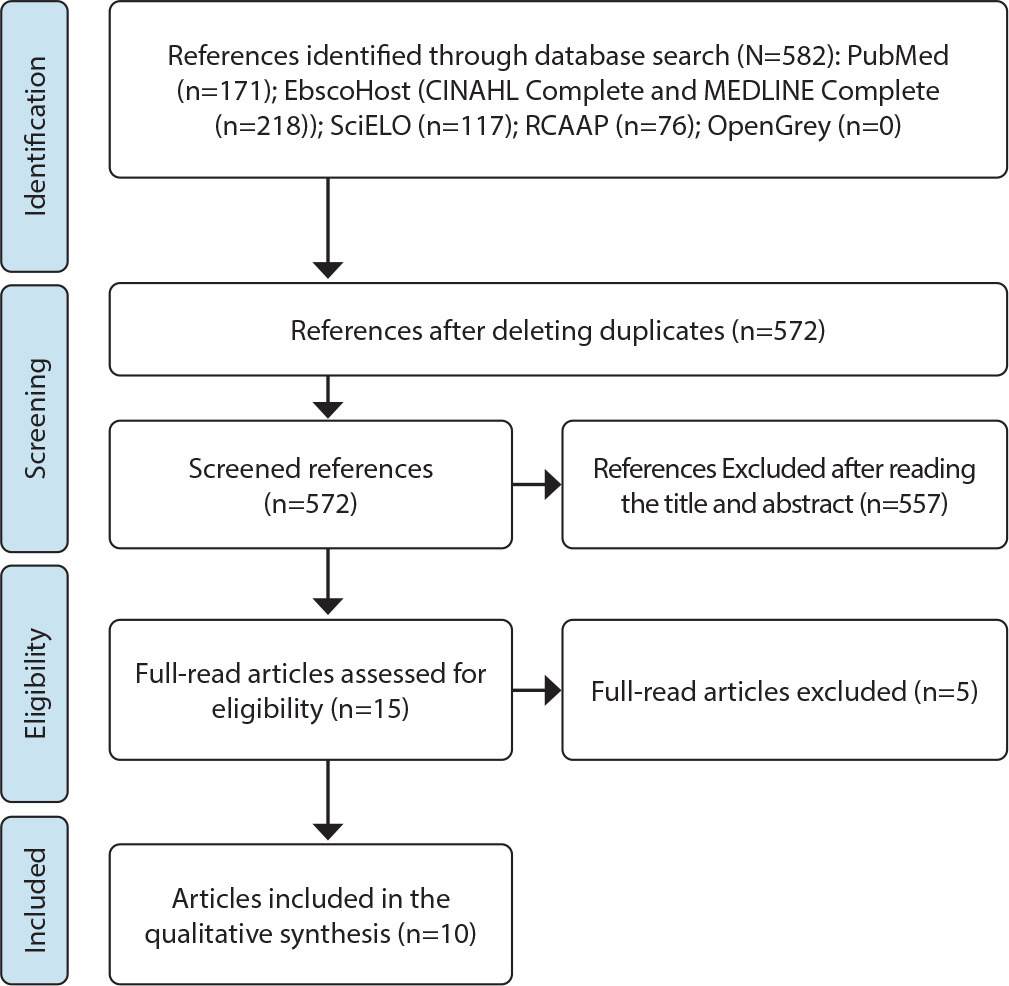
-
ORIGINAL ARTICLE11-22-2024
Prevalence of prescription and effectiveness of analgesia for treating vaginal delivery pain
Revista Brasileira de Enfermagem. 2024;77(5):e20230327
Abstract
ORIGINAL ARTICLEPrevalence of prescription and effectiveness of analgesia for treating vaginal delivery pain
Revista Brasileira de Enfermagem. 2024;77(5):e20230327
DOI 10.1590/0034-7167-2023-0327
Views0See moreABSTRACT
Objectives:
to assess pain management during labor.
Methods:
a cross-sectional study was carried out by reviewing medical records and conducting postpartum interviews. Prevalence and effectiveness of analgesia were assessed.
Results:
the prevalence of non-pharmacological analgesia was 61.86% of 215 women in labor in Obstetric Center and 82.51% of 62 in midwife-led unit. Prevalence of severe pain, on the Visual Analogue Scale, before and after non-pharmacological analgesia, was from 92.16% to 64.04% (p=0.00) in Obstetric Center and from 85.96% to 52.63% (p=0.01) in midwife-led unit. Prevalence of pharmacological analgesia in Obstetric Centers was 15.81%, with no variation in severe pain (p=0.57). Patients’ request for analgesia was associated with education (p=0.00) and pain intensity (p=0.02).
Conclusions:
non-pharmacological analgesia improved pain intensity. Prevalence of pharmacological analgesic prescription was lower than that identified in developed countries. Pain management needs to consider the preferences and needs of women in labor.
-
11-22-2024
Social Technology in the Prevention of Adolescent Violence: documentary production
Revista Brasileira de Enfermagem. 2024;77(5):e20230298
Abstract
Social Technology in the Prevention of Adolescent Violence: documentary production
Revista Brasileira de Enfermagem. 2024;77(5):e20230298
DOI 10.1590/0034-7167-2023-0298
Views0See moreABSTRACT
Objective:
To report the development of a technological innovation in the form of a documentary, aimed at disseminating actions for preventing violence against adolescents within the context of Primary Health Care.
Methods:
The documentary was developed through action research and interventions with adolescents in the territory of a Health Unit, conducted between 2020 and 2022, using Social Technology as both an action strategy and a conceptual reference.
Results:
The Social Technology proposal, created through workshops and seminars, resulted in a documentary focusing on violence prevention, involving 48 adolescents. The documentary’s script, collectively developed, portrays a soccer match between teams symbolizing peace and violence, with peace ultimately prevailing. The documentary is six minutes long.
Final Considerations:
The documentary has proven to be an effective Social Technology tool among adolescents, as it fosters critical thinking, is accessible, has potential for digital dissemination, and appeals to the target audience.
-
ORIGINAL ARTICLE11-22-2024
Study for the validation of evaluation indicators of electronic health records in immunization: Delphi technique
Revista Brasileira de Enfermagem. 2024;77(5):e20230112
Abstract
ORIGINAL ARTICLEStudy for the validation of evaluation indicators of electronic health records in immunization: Delphi technique
Revista Brasileira de Enfermagem. 2024;77(5):e20230112
DOI 10.1590/0034-7167-2023-0112
Views0See moreABSTRACT
Objective:
To develop and validate indicators for the evaluation of computerized systems in vaccination rooms.
Methods:
Methodological study. From the construction of a logical model for managing information produced in computerized systems in vaccination rooms, an evaluation indicator matrix was developed, and its contents were validated by specialists using the Delphi method. The degree of relevance and clarity were judged, using the following parameters: agreement percentage ≥ 90%; content validity index > 0.78. Internal consistency was tested using Cronbach’s alpha coefficient of 0.93.
Results:
Of the 55 proposed indicators, 48 were validated and composed the final matrix, with 13 in the structure dimension, 29 in the process dimension, and six in the outcome dimension.
Conclusion:
The set of indicators shows validity and high reliability, and can be used to evaluate computerized systems in vaccination rooms throughout the country, as it adhered to the recommendations of the National Immunization Program.
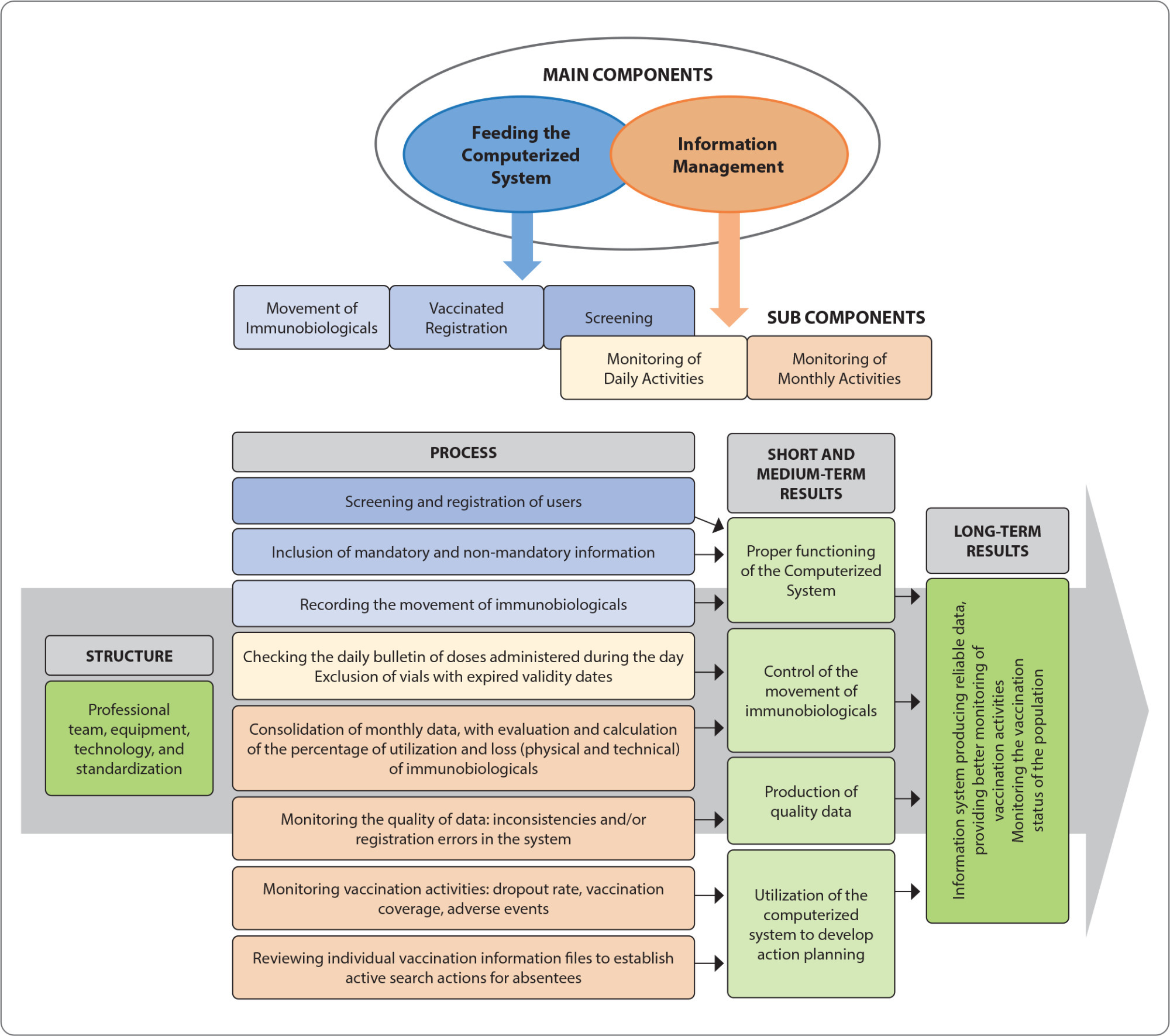
-
11-22-2024
Rondas a beira leito no ambiente hospitalar na perspectiva de equipes multiprofissionais de saúde
Revista Brasileira de Enfermagem. 2024;77(5):e20230493
Abstract
Rondas a beira leito no ambiente hospitalar na perspectiva de equipes multiprofissionais de saúde
Revista Brasileira de Enfermagem. 2024;77(5):e20230493
DOI 10.1590/0034-7167-2023-0493
Views0See moreRESUMEN
Objetivo:
Analizar la configuración de las relaciones de poder entre el equipo multiprofesional en el proceso de rondas de cabecera en el hospital.
Método:
Investigación cualitativa con datos analizados a través del análisis del discurso, basado en el marco teórico de Michel Foucault. De septiembre a diciembre de 2022, realizamos entrevistas y observaciones de campo con el equipo multiprofesional de un hospital de Belo Horizonte, Minas Gerais, Brasil, así como entrevistas cualitativas semiestructuradas con 37 profesionales.
Resultados:
Los participantes señalaron que las experiencias de los profesionales involucrados en las rondas de cabecera dependen de cómo el médico conduce el proceso, y el proceso centrado en el médico dificulta la participación de otros profesionales del equipo.
Consideraciones finales:
La forma en que los hospitales organizan las rondas de cabecera no promueve la articulación del conocimiento de sus profesionales. Además, dificulta la circulación del poder y perjudica el trabajo interdisciplinario en un proceso que mantiene al médico como actor principal de las decisiones clínicas.
-
ORIGINAL ARTICLE11-22-2024
Knowledge sharing: nurse managers’ practices
Revista Brasileira de Enfermagem. 2024;77(5):e20230287
Abstract
ORIGINAL ARTICLEKnowledge sharing: nurse managers’ practices
Revista Brasileira de Enfermagem. 2024;77(5):e20230287
DOI 10.1590/0034-7167-2023-0287
Views0See moreABSTRACT
Objective:
To analyze how management practices for sharing knowledge are developed in public hospitals in the context of nursing.
Methods:
Qualitative research, carried out with 15 nurse managers from six public hospitals, from July to September 2022. Data were collected through semi-structured interviews and analyzed according to content analysis and in a model for sharing knowledge at work.
Results:
Knowledge sharing in nursing occurs through intraand extra-organizational training (training, courses and events), use of digital communication tools (media and social networks) and individual and collective contact between professionals during the service (experiences, exchange of experiences and assessment feedback).
Final considerations:
Sharing knowledge is relevant to nursing work. To improve it, it must be understood that effective sharing occurs from person to person, in their daily practices, and must be conducted as a strategically planned process by nurse managers.
-
ORIGINAL ARTICLE11-22-2024
Interpersonal violence in the state of Espírito Santo: analysis of mandatory notifications between 2011 and 2018
Revista Brasileira de Enfermagem. 2024;77(5):e20230081
Abstract
ORIGINAL ARTICLEInterpersonal violence in the state of Espírito Santo: analysis of mandatory notifications between 2011 and 2018
Revista Brasileira de Enfermagem. 2024;77(5):e20230081
DOI 10.1590/0034-7167-2023-0081
Views0See moreABSTRACT
Objective:
To identify the frequency of notifications of interpersonal violence in Espírito Santo from 2011 to 2018, and the factors associated with this issue.
Methods:
This is a cross-sectional study in which all cases of interpersonal violence from the Information System for Notifiable Diseases in the state of Espírito Santo during the period from 2011 to 2018 were analyzed. Absolute and relative frequencies and 95% confidence intervals were calculated, as well as Poisson regression.
Results:
During the analyzed period, 27,277 cases were reported in Espírito Santo (P: 75%; 95% CI: 74.5-75.4), being more prevalent among females, children, and the elderly, individuals of black/mixed race, people without disabilities, and residents of urban areas. Regarding the perpetrator, there was a higher prevalence of individuals aged 25 years and older, males, with a current or former intimate partner relationship with the victim, and suspected alcohol use at the time of the aggression. In terms of the characteristics of the aggression, there was a higher prevalence of repeat violence, involving a single aggressor, and occurring in the residence.
Conclusions:
The notification of interpersonal violence in Espírito Santo showed a high prevalence and was associated with characteristics of the victim, aggressor, and event. This scenario reinforces the need for interventions such as professional qualification, expansion of intersectoral actions, and reformulation of public policies.
-
REVIEW07-29-2022
Technologies used by nursing to predict clinical deterioration in hospitalized adults: a scoping review
Revista Brasileira de Enfermagem. 2022;75(5):e20210570
Abstract
REVIEWTechnologies used by nursing to predict clinical deterioration in hospitalized adults: a scoping review
Revista Brasileira de Enfermagem. 2022;75(5):e20210570
DOI 10.1590/0034-7167-2021-0570
Views1See moreABSTRACT
Objective:
to map the early clinical deterioration technologies used in nurses’ professional practice in the care of hospitalized adult patients.
Methods:
this is a scoping review, according to Joanna Briggs Institute Reviewer’s Manual, which seeks to map the main technologies for detecting early clinical deterioration of hospitalized patients available for use by nurses, summarizing them and indicating gaps in knowledge to be investigated.
Results:
twenty-seven studies were found. The most present variables in the technologies were vital signs, urinary output, awareness and risk scales, clinical examination and nurses’ judgment. The main outcomes were activation of rapid response teams, death, cardiac arrest and admission to critical care units.
Final considerations:
the study emphasizes the most accurate variables in patient clinical assessment, so that indicative signs of potential severity can be prioritized to guide health conducts aiming to intervene early in the face of ongoing clinical deterioration.
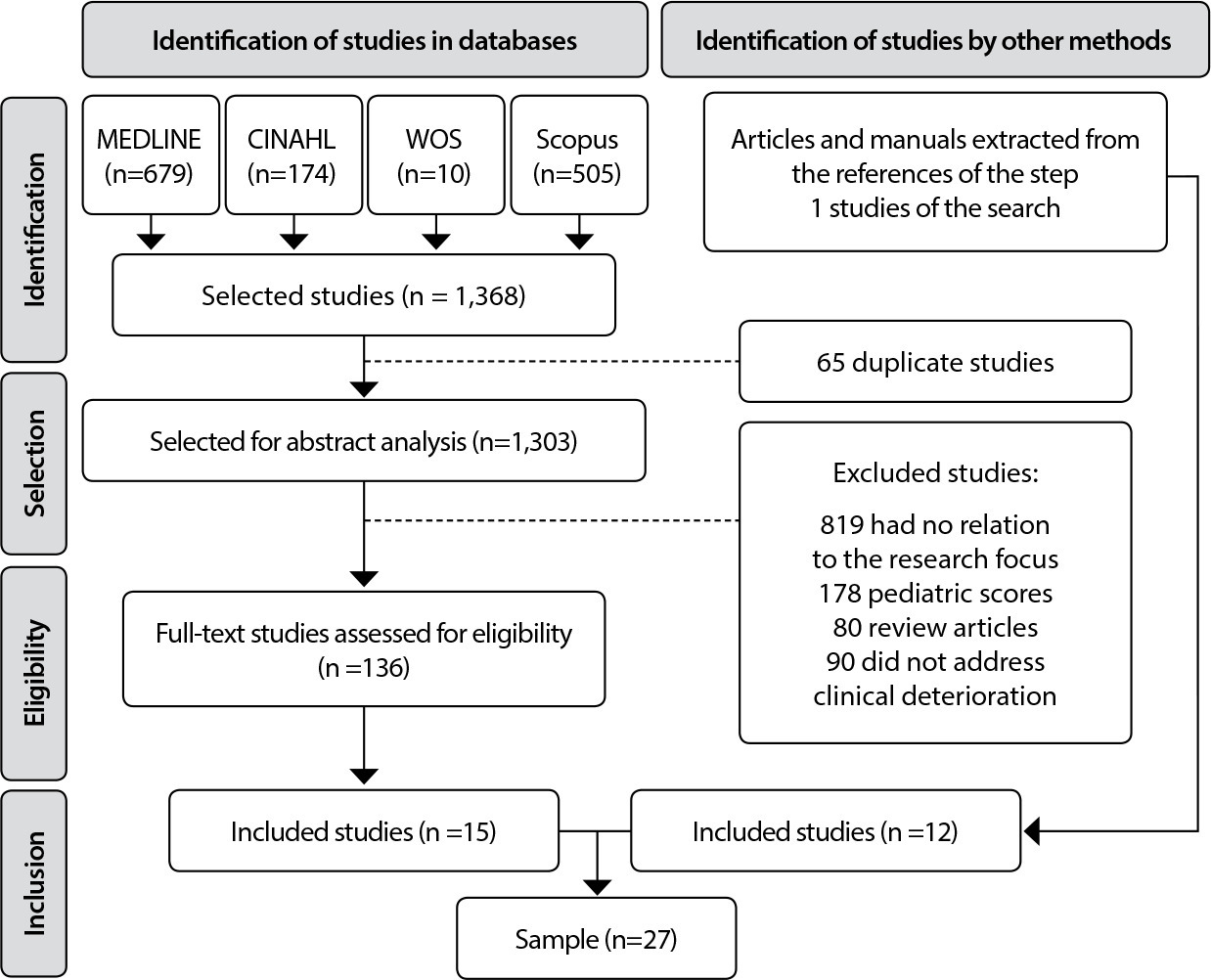
-
ORIGINAL ARTICLE05-09-2022
Core competencies for the training of advanced practice nurses in oncology: a Delphi study
Revista Brasileira de Enfermagem. 2022;75(5):e20210573
Abstract
ORIGINAL ARTICLECore competencies for the training of advanced practice nurses in oncology: a Delphi study
Revista Brasileira de Enfermagem. 2022;75(5):e20210573
DOI 10.1590/0034-7167-2021-0573
Views0See moreABSTRACT
Objective:
To map out and validate the core competencies for the training of advanced practice nurses in oncology.
Methods:
Exploratory-descriptive research with a quantitative approach using the Delphi technique. Initially, a matrix composed of six domains outlining 112 core competencies of the clinical nurse specialist in oncology was elaborated. The Likert scale was used to measure the degree of agreement. Data collection took place through the Google Forms® platform from February to May 2021. Data were compiled and analyzed based on expert suggestions and literature.
Results:
100 competencies achieved consensus (agreement level above 85.7%) in the first round; 13 new competencies were proposed by expert members; and 125 were validated during the Delphi technique.
Conclusion:
The mapping and validation of core competencies will allow the development of new training models aimed at advanced practice in oncology and future educational harmonization.
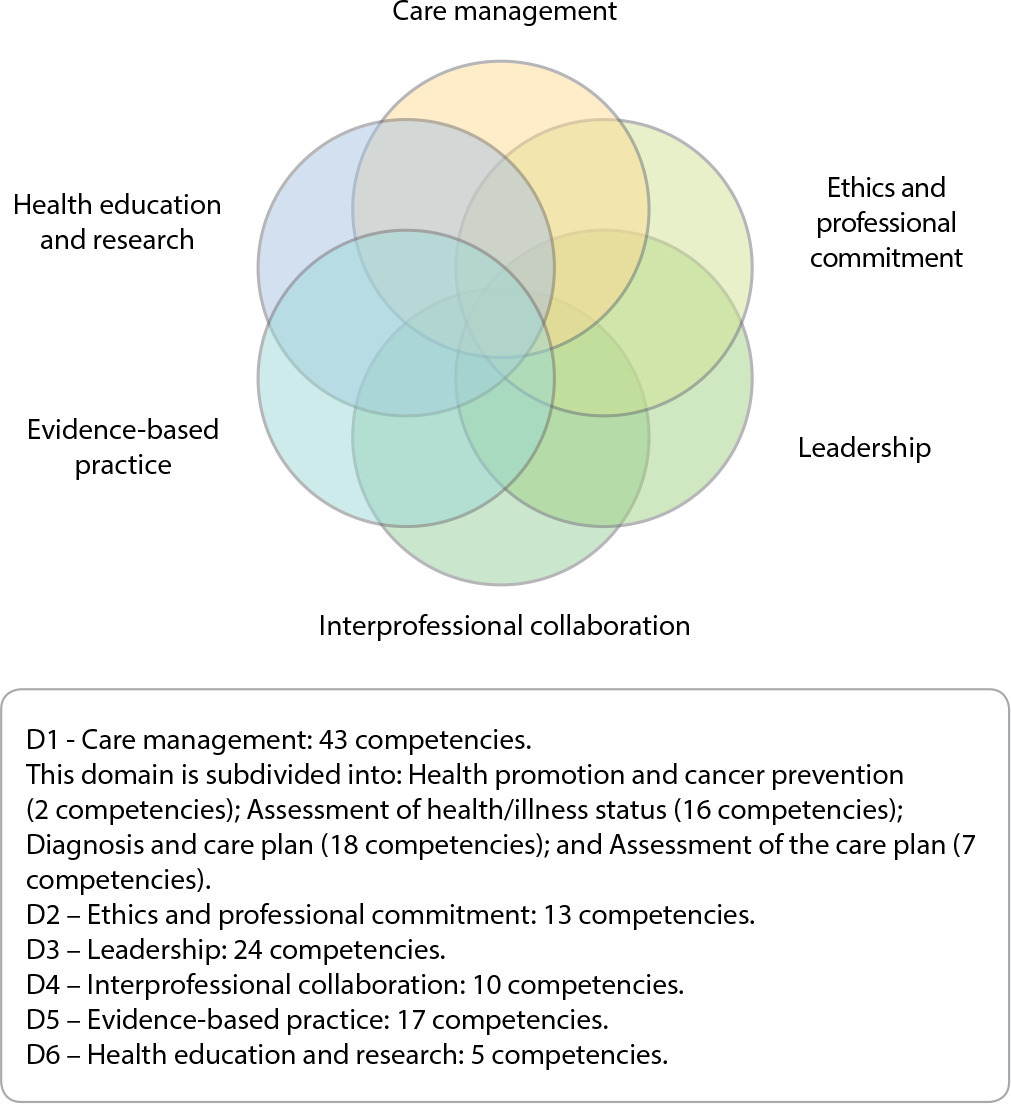
-
ORIGINAL ARTICLE10-21-2022
Technology for nursing consultation with transsexual women in the light of Leininger’s transcultural theory
Revista Brasileira de Enfermagem. 2022;75(5):e20210769
Abstract
ORIGINAL ARTICLETechnology for nursing consultation with transsexual women in the light of Leininger’s transcultural theory
Revista Brasileira de Enfermagem. 2022;75(5):e20210769
DOI 10.1590/0034-7167-2021-0769
Views0See moreABSTRACT
Objective:
to describe the construction and validation of a nursing consultation technology for transgender women.
Methods:
a methodological study developed in three stages with construction based on the Leininger’s Cross-Cultural Theory, content validation performed by experts in transgender sexual health and evaluation by nurses of care for transgender women. Items with a minimum agreement of 80% were considered validated, according to the Content Validity Index and binomial test.
Results:
the technology contains 59 items in three blocks: the first, for identification of the transsexual woman; the second, with the Clinical Data; and the third, regarding the Propaedeutics of Care. All items reached agreement higher than 0.8 and an overall Validity Index of 80%.
Conclusions:
the technology was content-validated and evaluated by nurses and can be applicable in clinical and outpatient practice as well as in academia to promote quality care for transgender women.
-
ORIGINAL ARTICLE07-22-2022
Cross-cultural adaptation, validation and reliability of the Medication Safety Thermometer tool for use in Brazil
Revista Brasileira de Enfermagem. 2022;75(5):e20210839
Abstract
ORIGINAL ARTICLECross-cultural adaptation, validation and reliability of the Medication Safety Thermometer tool for use in Brazil
Revista Brasileira de Enfermagem. 2022;75(5):e20210839
DOI 10.1590/0034-7167-2021-0839
Views0See moreABSTRACT
Objectives:
to perform cross-cultural adaptation, face and content validation and reliability analysis of the Medication Safety Thermometer tool for use in Brazil.
Methods:
the process of cross-cultural adaptation and validation followed the stages of translation, synthesis of translations, back-translation, content validation performed by experts, and face validation through pre-testing. Reliability was determined by calculating the Kappa coefficient.
Results:
the two translated versions were synthesized into a single version, which was back-translated and showed no divergences. The expert committee judged the adapted tool as equivalent, reaching a Content Validity Index higher than 0.8. The mean global understanding was 1.82, demonstrating face validity. The assessed items had Kappa coefficient greater than 0.61, showing agreement between observers.
Conclusions:
the cross-cultural adaptation of the tool was performed following an established methodology. The adapted tool showed inter-rater reliability and validity for use in Brazil.
-
ORIGINAL ARTICLE08-15-2022
Construction and validation of an educational video for patients in the perioperative period of robotic surgery
Revista Brasileira de Enfermagem. 2022;75(5):e20210952
Abstract
ORIGINAL ARTICLEConstruction and validation of an educational video for patients in the perioperative period of robotic surgery
Revista Brasileira de Enfermagem. 2022;75(5):e20210952
DOI 10.1590/0034-7167-2021-0952
Views1See moreABSTRACT
Objectives:
to build and validate educational technology, of the video type, aimed at teaching about the perioperative period of robotic surgery.
Methods:
methodological development study, following the integrative review phases: pre-production, production, post-production, and validation. The video was evaluated for content and appearance by 14 judges. Content validity (CVI) and appearance (AVI) and agreement (CI) indices were calculated, and the exact binomial test was applied, considering p>0.05 and a proportion of 0.80 of agreement.
Results:
the video included 13 themes, with a duration of seven minutes and 33 seconds. The items of the three dimensions evaluated presented excellent CVI, ranging between 0.86 and 1.00 (p>0.05), with a total CVI of 0.95, VAT of 0.94 and CI equal to 61.5%.
Conclusions:
the video included 13 themes, with a duration of seven minutes and 33 seconds. The items of the three dimensions evaluated presented excellent CVI, ranging between 0.86 and 1.00 (p>0.05), with a total CVI of 0.95, VAT of 0.94 and CI equal to 61.5%.
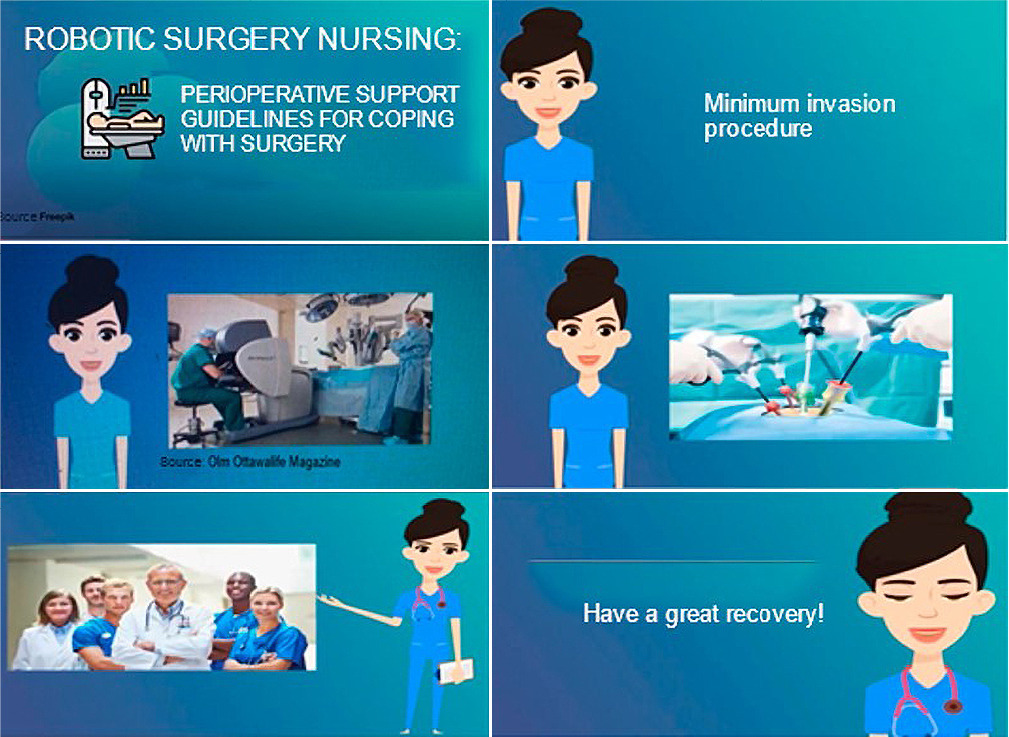
-
ORIGINAL ARTICLE09-26-2022
Educational technology for infants’ families to identify warning signs: a validation study
Revista Brasileira de Enfermagem. 2022;75(5):e20210964
Abstract
ORIGINAL ARTICLEEducational technology for infants’ families to identify warning signs: a validation study
Revista Brasileira de Enfermagem. 2022;75(5):e20210964
DOI 10.1590/0034-7167-2021-0964
Views0See moreABSTRACT
Objective:
To validate, with the target audience, the usability and appearance of a serialized album about the warning signs to the health of children below 2 months.
Method:
Methodological validation study with the target population of an educational material in the form of a serialized album. 11 mothers with children under 2 months of age participated. The domains evaluated were: Objectives, Organization, Writing Style, Appearance, and Motivation. Data were analyzed using descriptive and statistics, and the data agreement index was calculated.
Results:
The global data agreement index was high (0.99). Mothers had positive responses, recognizing the excellence of the material: attractive figures that were easy to understand.
Conclusion:
The validation of the serialized album provides mothers with the abilities and knowledge they need to identify warning signs in regard to the health of their children, providing them with autonomy, corresponsibility, and helping them develop better child health practices.
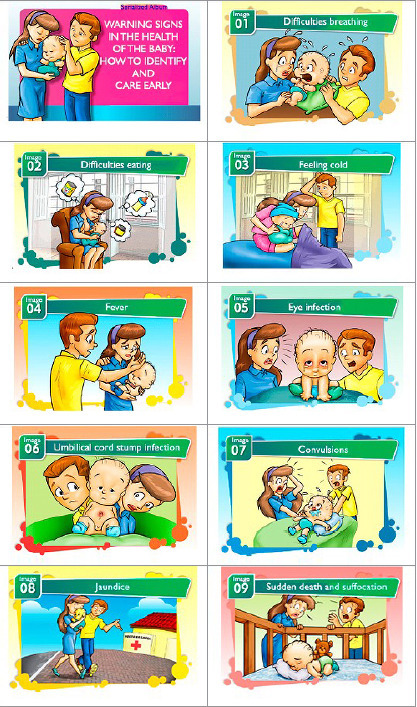
-
ORIGINAL ARTICLE10-17-2022
Validation of the Brazilian Portuguese version of the Venous International Assessment Scale and proposal of revision
Revista Brasileira de Enfermagem. 2022;75(5):e20220100
Abstract
ORIGINAL ARTICLEValidation of the Brazilian Portuguese version of the Venous International Assessment Scale and proposal of revision
Revista Brasileira de Enfermagem. 2022;75(5):e20220100
DOI 10.1590/0034-7167-2022-0100
Views0See moreABSTRACT
Objective:
To validate the Brazilian Portuguese translation and analyze the cultural adaptation of the Venous International Assessment Scale.
Methods:
Observational study by employing the Delphi technique and an equivalence evaluation by experts. The results were analyzed using item scores and by content validity index calculations of item, scale, and universal agreement.
Results:
Three rounds of evaluation were necessary for consensus. Explanatory contents were incorporated into the original scale throughout the process, resulting in a new version: VIA Scale – Revised. This scale obtained a content validity index of 0.96 and a universal agreement of 0.78. In the cross-cultural adequacy analysis phase, a score of 0.77 was obtained. The majority (90.5%) of the participants judged the scale’s decision support property as positive.
Conclusion:
The VIA Scale was validated and culturally adapted to the Brazilian Portuguese language, resulting in the VIA Scale – Revised (VIA-R).
-
ORIGINAL ARTICLE07-29-2022
Effects of guided imagery relaxation in hematopoietic stem-cell transplantation patients: a quasi-experimental study
Revista Brasileira de Enfermagem. 2022;75(5):e20220114
Abstract
ORIGINAL ARTICLEEffects of guided imagery relaxation in hematopoietic stem-cell transplantation patients: a quasi-experimental study
Revista Brasileira de Enfermagem. 2022;75(5):e20220114
DOI 10.1590/0034-7167-2022-0114
Views1See moreABSTRACT
Objective:
To analyze the effects of the technique of virtual reality guided imagery in the vital signs of hematopoietic stem-cell transplantation patients.
Method:
Quasi-experimental study with 35 participants who received an intervention using virtual reality guided imagery with progressive muscle relaxation, applied three times a week for four weeks in a referral hospital for transplants in the south of Brazil. Data collected included: temperature, arterial pressure, respiratory rate, heart rate, pain, and oxygen saturation, before and after each intervention. The comparisons were analyzed using Wilcoxon’s test.
Results:
There was a clinical significance between the mean measurements before and after for respiratory rate (p=0.00) in all stages, and for the variables Heart rate, Temperature, and Oxygen saturation from the 1st to the 12th measurements (p=0.05).
Conclusion:
The intervention was low cost, easy to apply, and showed positive effects, presenting itself as an option for patient-focused care.
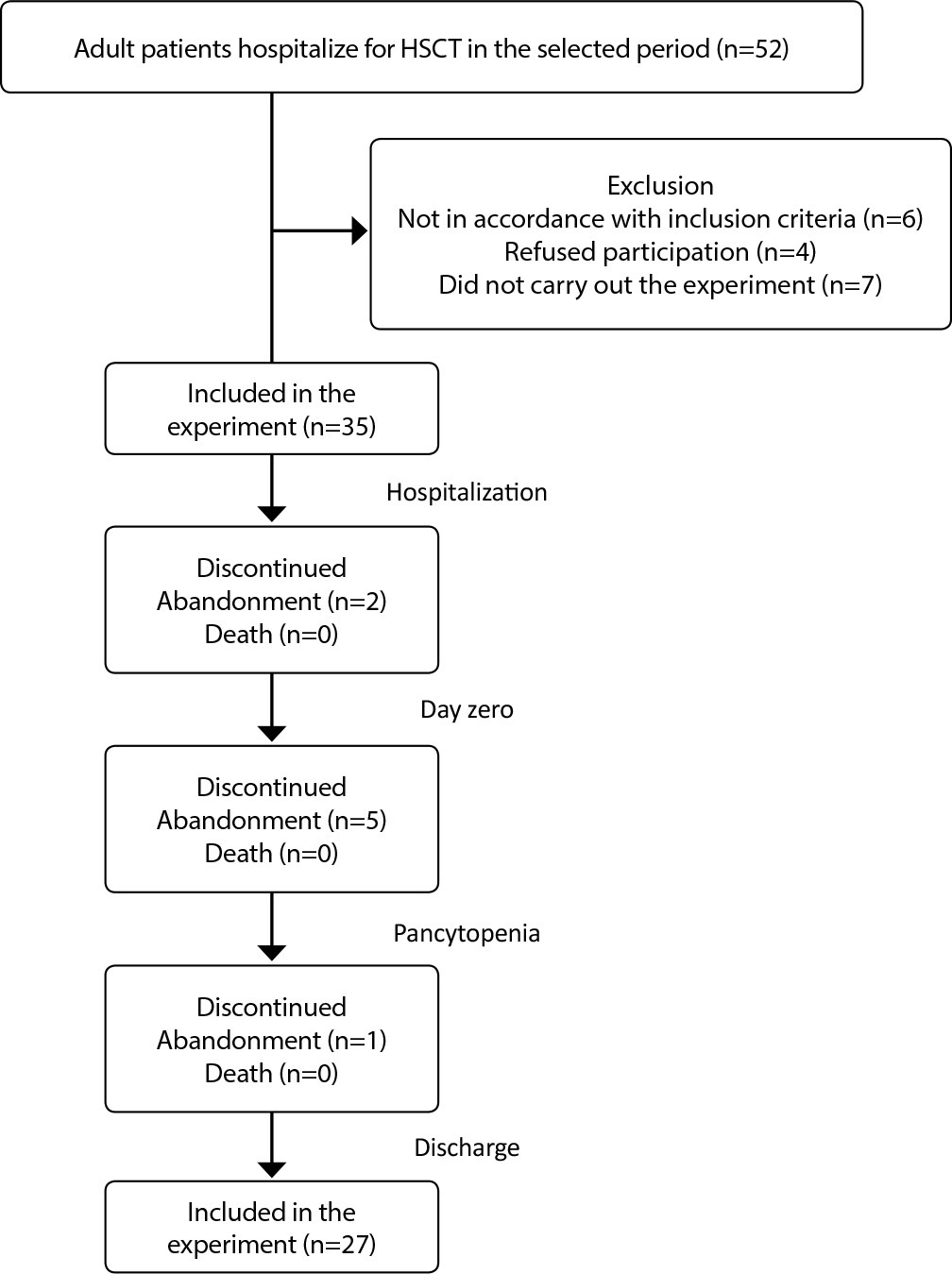
-
ORIGINAL ARTICLE07-13-2020
Mental health of nursing in coping with COVID-19 at a regional university hospital
Revista Brasileira de Enfermagem. 2020;73:e20200434
Abstract
ORIGINAL ARTICLEMental health of nursing in coping with COVID-19 at a regional university hospital
Revista Brasileira de Enfermagem. 2020;73:e20200434
DOI 10.1590/0034-7167-2020-0434
Views0See moreABSTRACT
Objective:
to identify prevalence and factors associated with anxiety and depression in nursing professionals who work to cope with COVID-19 at a university hospital.
Methods:
a cross-sectional observational study using a sociodemographic questionnaire and Hospital Anxiety and Depression Scale, with 88 nursing professionals. Data were analyzed using absolute and relative frequency and Statistical Package for the Social Sciences.
Results:
there was prevalence of anxiety (48.9%) and depression (25%). The majority of the sample consisted of women over 40 years old, married or in a common-law marriage, white, with higher education or graduate degree, with an income above 3,000.00 reais, public servants, working 40 hours a week and working in the hospital from 1 to 5 years.
Conclusion:
we must consider the impact on mental health nursing caused by COVID-19 and intervene with coping strategies to minimize the suffering of professionals.
-
REFLECTION04-22-2020
Thematic content analysis using ATLAS.ti software: Potentialities for researchs in health
Revista Brasileira de Enfermagem. 2020;73(3):e20190250
Abstract
REFLECTIONThematic content analysis using ATLAS.ti software: Potentialities for researchs in health
Revista Brasileira de Enfermagem. 2020;73(3):e20190250
DOI 10.1590/0034-7167-2019-0250
Views0See moreABSTRACT
Objective:
to describe the most important tools of ATLAS.ti Software and to associate them with the procedures of Thematic Content Analysis.
Method:
It is a theoretical reflection of the Content Analysis phases of Laurence Bardin, associating them with software tools Atlas.ti and showing its usefulness for data analysis in qualitative research.
Results:
historical contextualization and the available resources of Atlas.ti software with presentation of health research involving the phases of thematic content analysis.
Final considerations:
The Atlas.ti software assists in the accomplishment of the thematic content analysis being this promising association in health research.

-
REFLECTION10-26-2020
Nursing education: challenges and perspectives in times of the COVID-19 pandemic
Revista Brasileira de Enfermagem. 2020;73:e20200683
Abstract
REFLECTIONNursing education: challenges and perspectives in times of the COVID-19 pandemic
Revista Brasileira de Enfermagem. 2020;73:e20200683
DOI 10.1590/0034-7167-2020-0683
Views0See moreABSTRACT
Objective:
To discuss the challenges and perspectives of nursing education in times of the COVID-19 pandemic.
Methods:
Reflection study, with theoretical approach based on national and international publications, allied to the experience of researchers in the area of nursing education.
Results:
Four sections are identified: Nursing education: current affairs and perspectives; Education and technologies in time of pandemic: acceleration, alteration and paralysis; Difference between emergency, intentional and remote teaching; the return to the “new normality”: new structuring axes and legal norms.
Final considerations:
The conclusion is that longstanding challenges have emerged with the pandemic, and the processes of acceleration, change and paralysis have marked education in these times. Moreover, epidemiological, technological and psychological aspects should be more valued in the return to activities.
-
ORIGINAL ARTICLE11-13-2020
Social determinants of health and COVID-19 infection in Brazil: an analysis of the pandemic
Revista Brasileira de Enfermagem. 2020;73:e20200673
Abstract
ORIGINAL ARTICLESocial determinants of health and COVID-19 infection in Brazil: an analysis of the pandemic
Revista Brasileira de Enfermagem. 2020;73:e20200673
DOI 10.1590/0034-7167-2020-0673
Views0See moreABSTRACT
Objective:
To analyze the influence of socioeconomic, demographic, epidemiological factors, and the health system structure in the evolution of the COVID-19 pandemic in Brazil.
Methods:
Ecological study with variables extracted from databases, having the incidence and mortality by COVID-19 until August 23, 2020, in Brazilian states, as response variables. The magnitude of the associations was estimated using Spearman’s correlation coefficient and multiple regression analysis.
Results:
In the Brazilian states, 59.8% of variation in the incidence of COVID-19 was justified by income inequality, significant home densification, and higher mortality. In the case of mortality, those same variables explained 57.9% of the country’s variations in federal units.
Conclusion:
Our results indicate that socioeconomic factors influenced the evolution and impact of COVID-19 in Brazil. Thus, we suggest comprehensive actions to ensure economic conditions and strengthening of health networks for populations with socioeconomic vulnerability.
-
ORIGINAL ARTICLE02-27-2020
Prevalence of symptoms and quality of life of cancer patients
Revista Brasileira de Enfermagem. 2020;73(2):e20180287
Abstract
ORIGINAL ARTICLEPrevalence of symptoms and quality of life of cancer patients
Revista Brasileira de Enfermagem. 2020;73(2):e20180287
DOI 10.1590/0034-7167-2018-0287
Views0See moreABSTRACT
Objectives:
to analyze the prevalence of symptoms and their relationship with the quality of life of cancer patients.
Methods:
this is a cross-sectional study with 107 patients evaluated using a sociodemographic instrument, the hospital anxiety and depression scale (HADS) and the quality of life scale (EORTC-QLQ-C30). Pearson’s correlation test was used to evaluate the relationship between symptoms and quality of life.
Results:
prevalence of female patients (56.1%), 55 years as the mean age and 10 years of schooling. Fatigue (76.6%), insomnia (47.7%), pain (42.1%), loss of appetite (37.4%), anxiety (31.8%) and depression (21.5%) were identified. Anxiety and depression symptoms presented a negative correlation with quality of life and positive correlation with physical symptoms.
Conclusions:
fatigue, insomnia, pain and loss of appetite were the most common and most intense symptoms. Anxiety and depression symptoms presented a negative correlation with quality of life and positive correlation with physical symptoms.
-
ORIGINAL ARTICLE08-10-2020
Braden Scale in pressure ulcer risk assessment
Revista Brasileira de Enfermagem. 2020;73(6):e20190413
Abstract
ORIGINAL ARTICLEBraden Scale in pressure ulcer risk assessment
Revista Brasileira de Enfermagem. 2020;73(6):e20190413
DOI 10.1590/0034-7167-2019-0413
Views0See moreABSTRACT
Objective:
To analyze the applicability of the Braden Scale to individuals admitted to an Intensive Care Unit (ICU) with the nursing diagnosis Impaired Physical Mobility, in its prediction potential to develop pressure ulcer (PU).
Methods:
A cross-sectional, quantitative study that evaluated all patients hospitalized in an ICU between November 2016 and February 2017, with the Braden Scale.
Results:
The prevalence of PU was 35.8% (24/67), in male individuals 58.3% (14/24), diagnosed with ischemic CVA 51.9% (12/27), and with hemorrhagic CVA 7.4% (2/27). Among patients classified at severe risk of developing pressure ulcer, 83.3% (20/53) developed it, and 76.7% (33/53) did not develop it.
Conclusion:
The performance of the Braden Scale showed a balance between sensitivity and specificity, confirming it as a better predictive risk assessment instrument in this group of patients.
-
REVIEW03-24-2021
Strategies of active learning methodologies in nursing education: an integrative literature review
Revista Brasileira de Enfermagem. 2021;74(1):e20200130
Abstract
REVIEWStrategies of active learning methodologies in nursing education: an integrative literature review
Revista Brasileira de Enfermagem. 2021;74(1):e20200130
DOI 10.1590/0034-7167-2020-0130
Views0See moreABSTRACT
Objectives:
to analyze the scientific evidence on the strategies of active learning methodologies used in the training of nurses, as well as their contributions and obstacles in training.
Methods:
integrative literature review conducted with 33 selected articles in the Medical Literature Analysis and Retrieval System Online, Latin American and Caribbean Literature in Health Sciences, Nursing Database, Scopus, Web of Science and Education Resources Information Center databases.
Results:
among the strategies, simulation, problem-based learning and flipped classroom were highlighted. The active search, the integration of theory and practice and group work were examples of contributions to the training of nurses. However, the lack of preparation of the actors and the lack of structural support contribute to the dissatisfaction of the students.
Final Considerations:
the active learning methodology places the student at the heart of the learning process, favors critical thinking and the ability to make decisions.
-
ORIGINAL ARTICLE09-16-2019
Validation of educational booklet: an educational technology in dengue prevention
Revista Brasileira de Enfermagem. 2019;72(5):1318-1325
Abstract
ORIGINAL ARTICLEValidation of educational booklet: an educational technology in dengue prevention
Revista Brasileira de Enfermagem. 2019;72(5):1318-1325
DOI 10.1590/0034-7167-2018-0771
Views0See moreABSTRACT
Objective:
to validate a booklet on dengue prevention in order to make it an educational technology to be used with the population.
Method:
methodological study, carried out with two groups of judges specialized in health and other areas. For data analysis, the calculation of Content Validity Index was carried out.
Results:
the booklet, in general, was considered valid by the expert judges, since it obtained an overall CVI of 70%. However, it has undergone a textual and aesthetic re-elaboration. The changes were based on the substitution of expressions, phrases, information additions and language adequacy. The illustrations were redone, adding clarity, expressiveness, movement, interaction and contextualization.
Conclusion:
the booklet is valid to be used for the population, with the purpose of informing, in a playful way, the forms of prevention and combat to mosquito transmitting dengue.

Search
Search in:
Nuvem de Tags
Adolescente (85) Atenção Primária à Saúde (239) COVID-19 (91) Criança (91) Cuidados de Enfermagem (269) Educação em Enfermagem (151) Educação em Saúde (139) Enfermagem (930) Enfermagem Pediátrica (86) Estudantes de Enfermagem (77) Estudos de Validação (131) Família (87) Idoso (208) Promoção da Saúde (99) Qualidade de Vida (104) Saúde do Trabalhador (86) Saúde Mental (145) Saúde Pública (82) Segurança do Paciente (150) Tecnologia Educacional (100)



